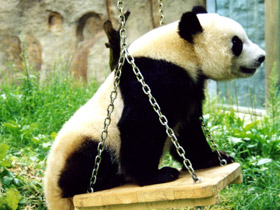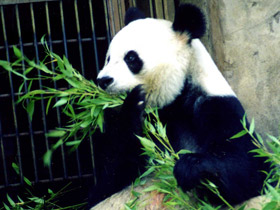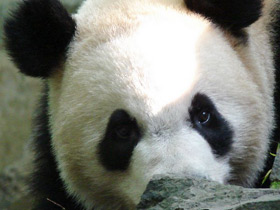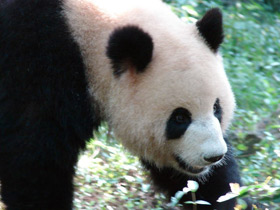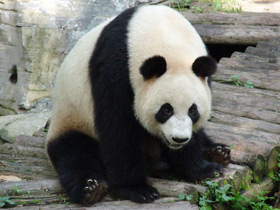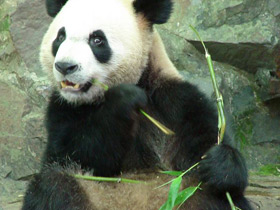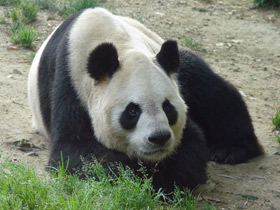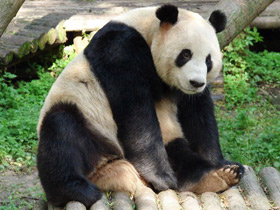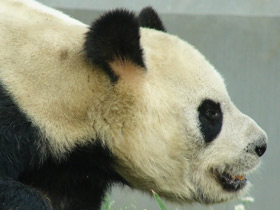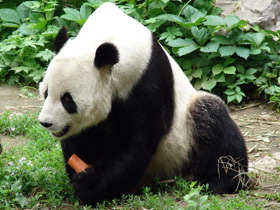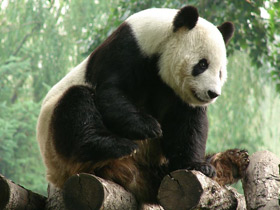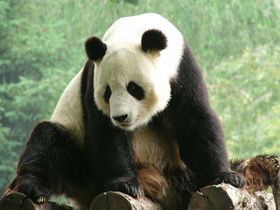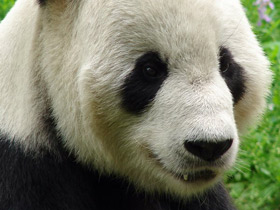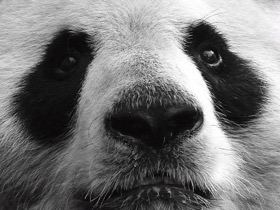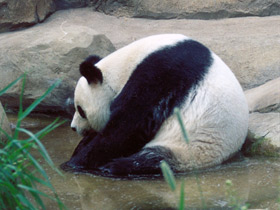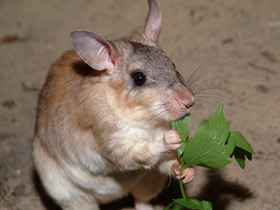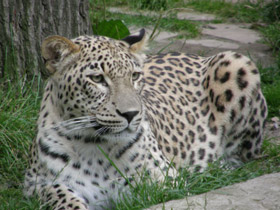The giant panda, panda bear or panda (Ailuropoda melanoleuca)
Giant panda видео
The giant panda (Ailuropoda melanoleuca), sometimes called a panda bear or simply panda, is a bear species endemic to China.
Origin and appearance
Ailuropoda melanoleuca is a species of mammal of the carnivore order. DNA studies classify it as a member of the bear family (Ursidae), with the spectacled bear being its closest relative, belonging to the tremarctine subfamily. The red panda, on the other hand, belongs to a separate family of its own, the Ailuridae.
It is one of the most publicised animals in the world. Its striking black and white colour and its resemblance to a giant teddy bear make it easily recognisable and very popular. Scientists have long argued over the panda's systematic position: it was attributed to raccoons, bears or assigned to a separate family.
Ailuropoda melanoleuca has a massive head with a short, broad snout, a robust body and - unlike other bears - a rather long tail, up to 12 cm.
It is a rather large animal: its weight can reach 130 kg, and its body length is almost 2 m. Ailuropoda melanoleuca has broad, hairy, rounded feet with strong claws that do not rest completely on the ground. The soles and the base of each toe have well-developed bare pads that facilitate grasping smooth bamboo stems.
A striking feature of these animals is an extra, opposable "finger" on the hand, known as the panda thumb or "pre-finger" (actually a modified wrist bone) that allows them to manipulate even the finest bamboo shoots.
Nutrition
The broad, flat molars of Ailuropoda melanoleuca are perfectly adapted for chewing hard bamboo, and their oesophagus and stomach are lined with layers of elastic mucous tissue to protect them from bamboo chips. This is not surprising, as Ailuropoda melanoleuca feeds almost exclusively on bamboo, occasionally including in its diet some other plants such as lily and crocus, mushrooms, as well as eggs, small birds, rodents, insects and carrion. It usually feeds in a sitting position (less frequently lying down), grasping bamboo shoots with the index finger and the first two toes, tearing off the tough outer layer of the plant with its teeth and then slowly chewing the peeled stalk. Ailuropoda melanoleuca uses both young succulent shoots and old stems up to 13 mm in diameter, and even roots. To satiate itself on such a low-calorie diet, it has to eat up to 18 kg of bamboo a day. This is also the reason why these animals are very slow and tend to move only when necessary.
Peculiarities
Ailuropoda melanoleuca is an excellent tree climber, showing acrobatic skills: it can climb the tops of tall trees and is somehow able to cling to even the thinnest branches. In addition, pandas have a remarkable and very funny ability to somersault down steep mountain slopes to escape pursuit. In doing so, they press their front paws against their eyes to protect them and their hind paws against their belly.
Reproduction
The reproduction rate of Ailuropoda melanoleuca is very low. These animals reach sexual maturity late, only at 6-7 years of age. They give birth to 1-2 (very rarely 3) young, but usually soon after birth the mother chooses the strongest young and feeds only her, the others are killed. In zoos, it is often possible to trick the female bear into giving birth to both cubs by replacing them with her every few days.
All bears give birth to underdeveloped cubs, but Ailuropoda melanoleuca takes this characteristic to the extreme. Newborn cubs weigh no more than 150 g, i.e. a thousand times less than the body weight of an adult animal. Their eyes open at 3 weeks of age, and milk feeding lasts about 46 weeks. Ailuropoda melanoleuca are extraordinarily affectionate mothers, rarely leaving their young alone and often playing with them.
Predators
Although adult giant pandas have few natural predators other than humans, young cubs are vulnerable to attacks by snow leopards, yellow-throated martens, eagles, feral dogs, and the Asian black bear. Sub-adults weighing up to 50 kg (110 lb) may be vulnerable to predation by leopards.
Conservation status
Ailuropoda melanoleuca is included in the IUCN Red List as one of the rarest animals. In China, the great panda is declared a national treasure and the death penalty is prescribed for killing it.
Classification
For many decades, the precise taxonomic classification of the giant panda was under debate because it shares characteristics with both bears and raccoons. However in 1985, molecular studies indicate the giant panda is a true bear, part of the family Ursidae. These studies show it diverged about 19 million years ago from the common ancestor of the Ursidae; it is the most basal member of this family and equidistant from all other extant bear species. The giant panda has been referred to as a living fossil.
Subspecies
Two subspecies of giant panda have been recognized on the basis of distinct cranial measurements, colour patterns, and population genetics.
- The nominate subspecies, Ailuropoda melanoleuca melanoleuca, consists of most extant populations of the giant panda. These animals are principally found in Sichuan and display the typical stark black and white contrasting colours.
- The Qinling panda, Ailuropoda melanoleuca qinlingensis, is restricted to the Qinling Mountains in Shaanxi at elevations of 1,300–3,000 m (4,300–9,800 ft). The typical black and white pattern of Sichuan giant pandas is replaced with a light brown and white pattern. The skull of Ailuropoda melanoleuca qinlingensis is smaller than its relatives, and it has larger molars.
A detailed study of the giant panda's genetic history from 2012 confirms that the separation of the Qinlin population occurred about 300,000 years ago, and reveals that the non-Qinlin population further diverged into two groups, named the Minshan and the Qionglai-Daxiangling-Xiaoxiangling-Liangshan group respectively, about 2,800 years ago.










